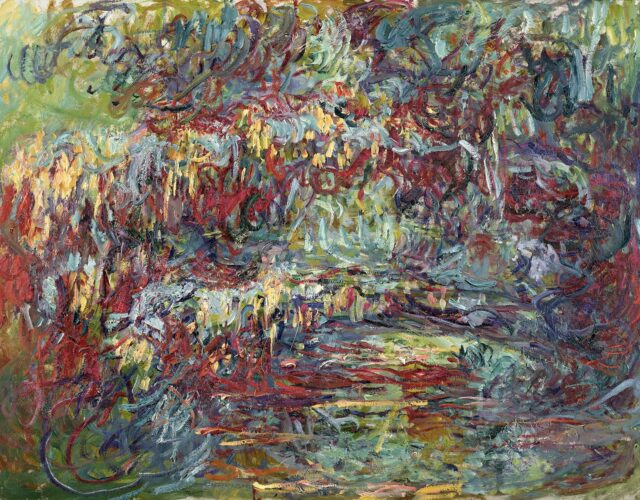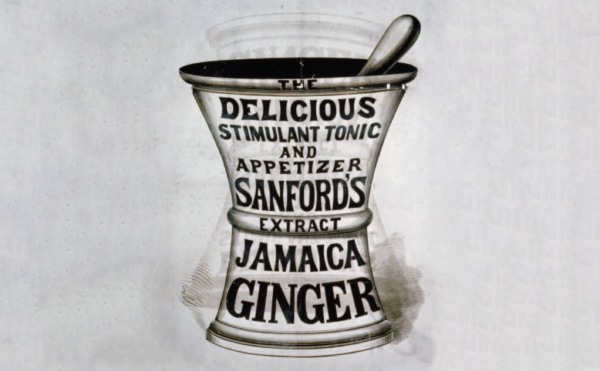In this episode of The Disappearing Spoon, host Sam Kean shares how impressionist painter Claude Monet almost lost “the greatest eye in painting history” and gained an otherworldly sense in the process.
About The Disappearing Spoon
The Science History Institute has teamed up with New York Times best-selling author Sam Kean to bring a second history of science podcast to our listeners. The Disappearing Spoon tells little-known stories from our scientific past—from the shocking way the smallpox vaccine was transported around the world to why we don’t have a birth control pill for men. These topsy-turvy science tales, some of which have never made it into history books, are surprisingly powerful and insightful.
Credits
Host: Sam Kean
Senior Producer: Mariel Carr
Producer: Rigoberto Hernandez
Associate Producer: Padmini Raghunath
Audio Engineer: Jonathan Pfeffer
Transcript
Painter Claude Monet was in despair. The year was 1922, and he admitted to friends that he simply couldn’t go on like this. He would have to give up painting forever.
The origins of his despair were simple—his eyes. Monet’s fellow artist Paul Cezanne once said that, quote, “Monet was only an eye—but my god, what an eye.” It was true. Monet famously painted ponds and water lilies, and he was so obsessive about the light and color that he often returned to the same scene dozens of times to capture every nuance. Few painters in history could match his visual precision.
But late in life, Monet’s vaunted eyes came under threat. He developed cataracts and, painfully slowly, began going blind. The ordeal crushed his spirt. To him, life without painting was no life at all. He’d already tried to kill himself once as a young man, and he surely must have considered suicide again.
There was another option, however. Monet could undergo surgery to remove the cataracts. Nowadays, cataract surgery is routine—quick, safe, easy. Back then, it was a different story. Monet had in fact seen fellow painters lose everything after unsuccessful cataract operations.
But eventually, with his livelihood on the line, Monet went under the knife. And remarkably, the surgery introduced a whole new phase in his artistic career.
Why? Because the operation seemingly changed how his eyes worked. It made them, in some ways, even better than before.
Now, this might seem unfair, given how good his eyes were already. But as we now know, the surgery Monet was terrified to face actually gave his eyes something close to a human superpower. The ability to see a whole new kind of color.
Before we explain what happened to Monet’s eyes, we need to take a quick detour into how vision works.
As you might remember from high-school biology, we have two types of cells in our eyes to detect light—rods and cones. Rods detect the presence of light, while cones detect specific colors.
Most mammals have just two types of cones, and therefore have relatively limited color vision. For example, stop signs look blaring red to us. But dogs can’t see red because they lack the right cone. Red just looks blah to them—grey and muted.
Humans have three cones, making us trichromatic. We’re especially good at telling apart shades of green. That probably traces back to our heritage as primates. Gorillas and chimps eat tons of leaves and shoots, and they need to notice subtle distinctions between leaves in different states of growth and decay. Our strong green color sense helps with that.
Trichromatic vision is actually kind of rare. Again, most mammals have two cones, and most animals in general have four cones, meaning they can see hues and shades that we can’t. It’s kind of hard to imagine what the world looks like to a creature with four cones, but I always picture Dorothy opening to door to a Technicolor Oz. Maybe not quite that dramatic, but with four cones, the world would suddenly look richer.
Some animals can also see a wider range of light. The human visible spectrum starts at red and ends at purple/violet. But beyond normal violet light, there’s also ultraviolet, or UV light, which has shorter wavelengths.
You might know that the sun releases ultraviolet light. It’s what causes suntans. Ultraviolet light also damages cells, which is why we wear sunscreen, to block UV light.
To us, UV light is invisible. But many insects especially can see ultraviolet light. Some even depend upon it to survive. There are certain butterflies where, to humans, males and females look absolutely identical. But if we could see ultraviolet light, we’d notice that males and females actually have different patterns of spots. It’s like invisible ink on their wings.
This also happens with flowers. Some plain-looking species of flowers actually have all sorts of ultraviolet spots and stripes and swirls. They produce these gorgeous patterns to attract bees, who can also see ultraviolet.
In groping around to describe these colors, some scientists call them “bee purple.” Again, it’s hard to imagine, but to bees, bee purple would look as different from regular purple as, say, green and blue look to us. There’s a whole world of color out there right under our noses that’s completely invisible.
And with all that in mind, we can now return to Monet.
In some ways, Monet’s health shaped his whole life as a painter. As a young man he joined the army in 1861 and got posted to Algeria. He came down with typhoid fever there, and during the recovery from typhoid, he took his first painting class.
A few years later, as a struggling artist in Paris, he decided to commit suicide by flinging himself off a bridge. He survived the attempt, and went to recuperate outside of Paris. While there, he fell in love with the countryside, and soon made it his life’s mission to paint natural scenes.
Monet eventually moved to Giverny, a village 45 miles northwest of Paris. There, he set up a Japanese-style garden with a pond and water lilies and a bridge. He would paint these lush gardens over and over the rest of his life. By the late 1800s, this work had won him the renown he craved. He became an international treasure.
And then, it was all snatched away from him. In 1905, the year he turned 65, Monet noticed that his normally 20/20 eyesight was getting fuzzy. By 1912, his vision had dropped to an estimated 20/50, and kept sinking.
Even worse, his most prized skill—his sense of color—started to dull. Colors just didn’t pop for him like they used to. Everything looked a bit browner, a bit muddier, each year.
Monet finally consulted an eye doctor, and received devastating news. He had cataracts.
Cataracts arise when proteins build up on the lenses of the eye. This turns the lens yellow, and the proteins there block and scatter light. People can develop cataracts for multiple reasons, but with Monet, some historians have speculated that the lead-based paints he used might have been the culprit.
Regardless, Monet had a very human reaction to his diagnosis. He ignored it completely, hoping it would just go away. Meanwhile, he kept painting as much as possible, however difficult it was. Because cataracts can cause glare, he had to wear floppy straw hats outdoors now. And he could only paint near dawn and dusk, when the light was gentler.
Naturally, though, ignoring his problem fixed nothing, and his eyesight continued to deteriorate. Between 1912 and 1918, his vision dropped from roughly 20/50 to 20/100. By 1922, he was down to 20/200, legally blind.
Monet’s painting was deteriorating, too. Instead of fine, intricate brushstrokes, now his brushstrokes became coarse and thick. There was no more light touch, no airiness.
His color schemes changed as well. He had special trouble seeing “cool” colors like blue and green. For a nature painter, this was a huge blow. Lilies looked brownish now, and the ponds looked like stagnant swamps. In some pictures, you can practically smell the fetid gas.
As things got worse, Monet tried to make up for the muted greens and blues by dialing other colors up—fiery reds and yellows. In some cases, his beloved Japanese gardens resembled an inferno. It was like Monet’s own private vision of hell.
As he grew more desperate, Monet began visiting doctors as far away as London, begging for treatment. Each one told him the same thing: he needed surgery. But Monet always refused. And in his defense, he wasn’t just being stubborn. He’d seen cataract operations go wrong before. Take the case of Mary Cassatt.
Cassatt was an American painter a few years younger than Monet. She worked in Paris, and was famous for her tender pictures of women and children. She had cataracts as well, and underwent surgery in 1917.
Given the risks of cataract surgery then, doctors often did one eye at a time. That way, in case something went wrong, you still had a backup eye. Here, the doctors started with Cassatt’s right eye. They sliced it open and removed the cloudy yellow lens. But it did no good. Her eyesight actually got worse afterward.
Still, Cassatt was determined to resume painting, so doctors operated on the other eye in 1919. That surgery failed as well. Afterward, she was more or less blind. She never picked up a paintbrush again.
The thought of Mary Cassatt left Monet with cold sweats. He would never let that happen to him. As long as he could paint even slightly, he refused the operation.
But cataracts wait for no man. Things got so bad that, by 1922, he could barely tell certain colors apart. He had to label his paint tubes with big letters, and then put each color in the same spot on his palette every day and memorize its location. Otherwise, the pigments all looked the same to him.
Eventually, Monet had no choice but to face the dreaded surgery. It took place in January 1923.
Again, the doctors operated on one eye only—most sources say the right. And during recovery, he had to lie absolutely still for days, with his head jammed between heavy sandbags to make sure he couldn’t move. Then for weeks afterward he had to wear bandages around his eye, which itched like crazy. He began clawing at them like a dog.
So what were the results? Did Monet leap up from the sandbags in joy, the cataract scales having fallen from his eyes?
Hardly. In fact, the aftermath of the surgery was every bit as bad as he feared. When the bandages came off, he had to wear special glasses that curved and distorted everything like a funhouse mirror. He called it a “terrifying” experience, and began lashing out at everyone around him. He was convinced that, like Mary Cassatt, his career was over.
Ultimately, however, Monet escaped Cassatt’s fate. However slowly, his eye healed. And in 1924 he finally got a new pair of glasses specially crafted for people missing a lens. The glasses were expensive: a single pair cost as much as a four-room luxury apartment. But as an international treasure, Monet could afford them. And lucky for him, they worked. His terrifying funhouse world finally started to look normal.
In fact, it started to look better than normal. A few minutes ago, I mentioned that human beings cannot see ultraviolet light. But there’s actually more to the story.
In truth, the cones in our eyes can perceive UV light if given the chance. It’s faint, but our retinas can pick it up.
So then why can’t we see the spots on butterflies? Or the patterns on flowers that bees do? Because the lenses in our eyes normally filter ultraviolet light out.
But remember—Monet suddenly didn’t have a lens in one eye. As a result, when he recovered, he could now see some ultraviolet light. He could actually perceive that mysterious bee purple. That whole spritely world of hidden figures and patterns in nature was suddenly open to him.
You can glimpse this in his paintings. To us mere mortals, water-lily flowers look plain white. They did to Monet once, too.
But after his surgery, Monet started rendering lilies with overtones of blue and purple, because that’s how he saw them now. He had superhuman vision.
Monet isn’t alone here, either. Eye surgeons still remove the lenses of cataract patients today, and usually replace them with artificial lenses that block UV light. But prior to the 1980s, the lenses did not block out ultraviolet light, and not everyone gets the lenses anyway.
As a result, such people can perceive those spotted butterflies and swirly flowers. More prosaically, when they visit pubs, they suddenly notice the ultraviolet blacklights that bartenders use to weed out counterfeit bills. To most people black lights are basically invisible. To people without lenses, they’re glaring.
You can see examples of Monet’s cataract paintings, at patreon.com/disappearingspoon. They make for fascinating viewing. There’s also a bonus episode there about some other aspects of the human eye, including the surprisingly fancy science of blinking. You’d be shocked at how sophisticated blinking is. That’s patreon.com/disappearingspoon.
Again, some of Monet’s paintings from this time look fiery and tormented. And frankly, we’re lucky these pictures even exist today.
You see, after his surgery, Monet pretty much renounced all the paintings from that portion of his career. He hated the coarse brushstrokes on the canvas, and especially hated the strange, garish colors. There are stories of him actually smuggling paint into galleries and “correcting” pictures on the wall when no one was looking.
Other pictures, he thought, were simply not salvageable. As he once said, “I would be seized by a frantic rage” upon seeing them. And if given the chance, he would destroy them, slashing them with a pen knife. Monet did not mess around when it came to art.
But the thing is, some scholars today see these cataract paintings as valuable in their own way. They’re the product of his diseased eyes, no question. But knowing how people with cataracts view the world is important, both for eye doctors and for those of us who might have to deal with cataracts someday, either in loved ones or ourselves.
The pictures are artistically important as well. By the 1920s, the painting world had started to move from Impressionism to even less representational art. In these new movements, painters often used colors in novel ways to distort images.
Colors didn’t need to be photograph-like, either. You could make the ocean red or the sky green, or whatever else captured your emotional state.
However inadvertently, Monet had done something similar with his garish colors and thick brush strokes. It was less representational, more abstract. So even though Monet hated the cataract paintings, some scholars see them as a bridge between nineteenth-century Impressionists and twentieth-century Abstract Expressionists. It might have been an accident, but history has swerved before on less than that.
In the end, I’m glad we have all three Monets. Of course, his fame will always rest on the first one, the bold Impressionist. But the torment of the cataract-ridden Monet adds a new dimension to his story. We can imagine his torment—the greatest eye in painting history growing dimmer and dimmer. It’s as poignant as Beethoven going deaf.
But unlike with Beethoven, Monet’s story ends happily. He lost a lens, but gained the power to see ultraviolet light. Great artists always see the world differently than the rest of us. And in the twilight of Monet’s career, this was literally true. He lived in a world the rest of us can only imagine.




